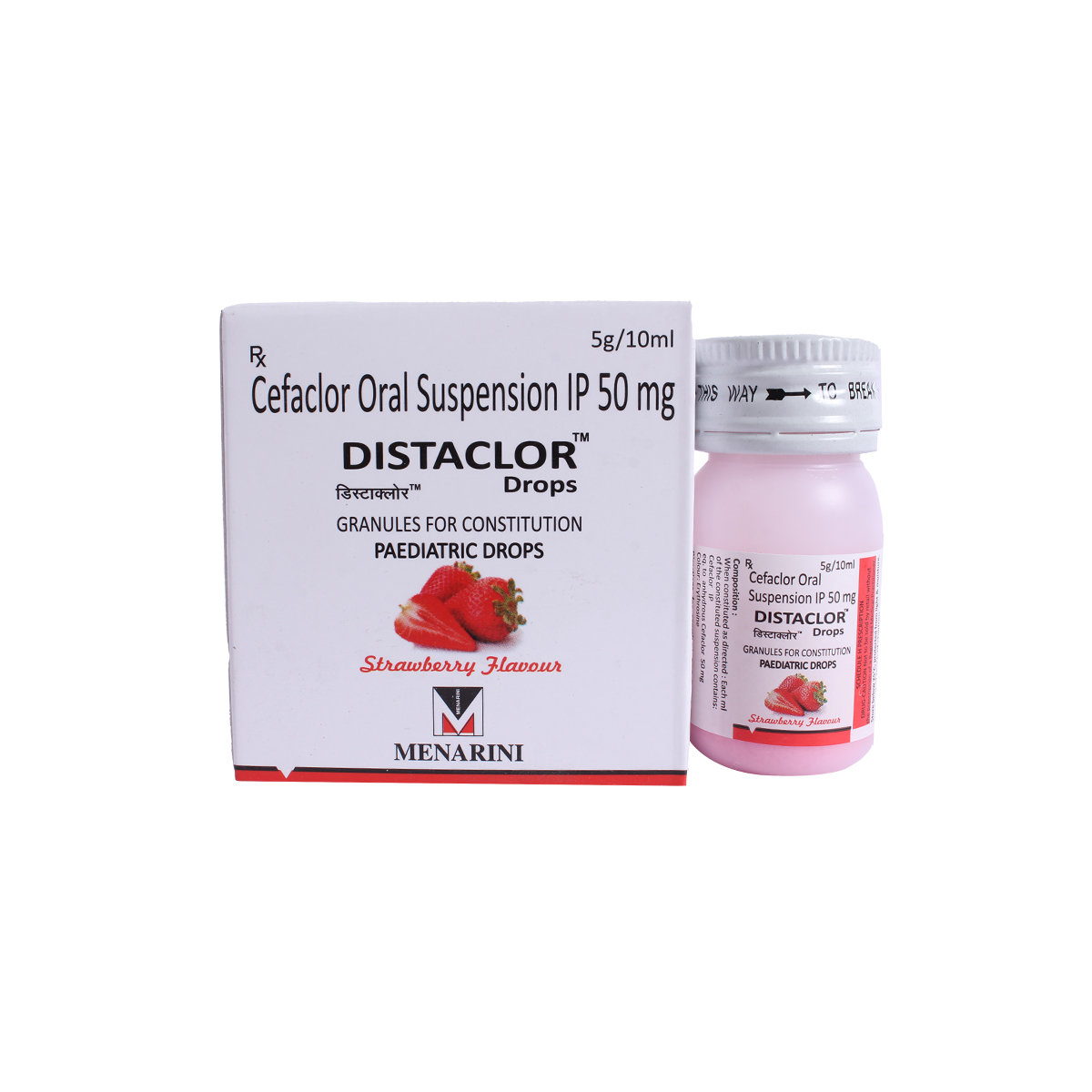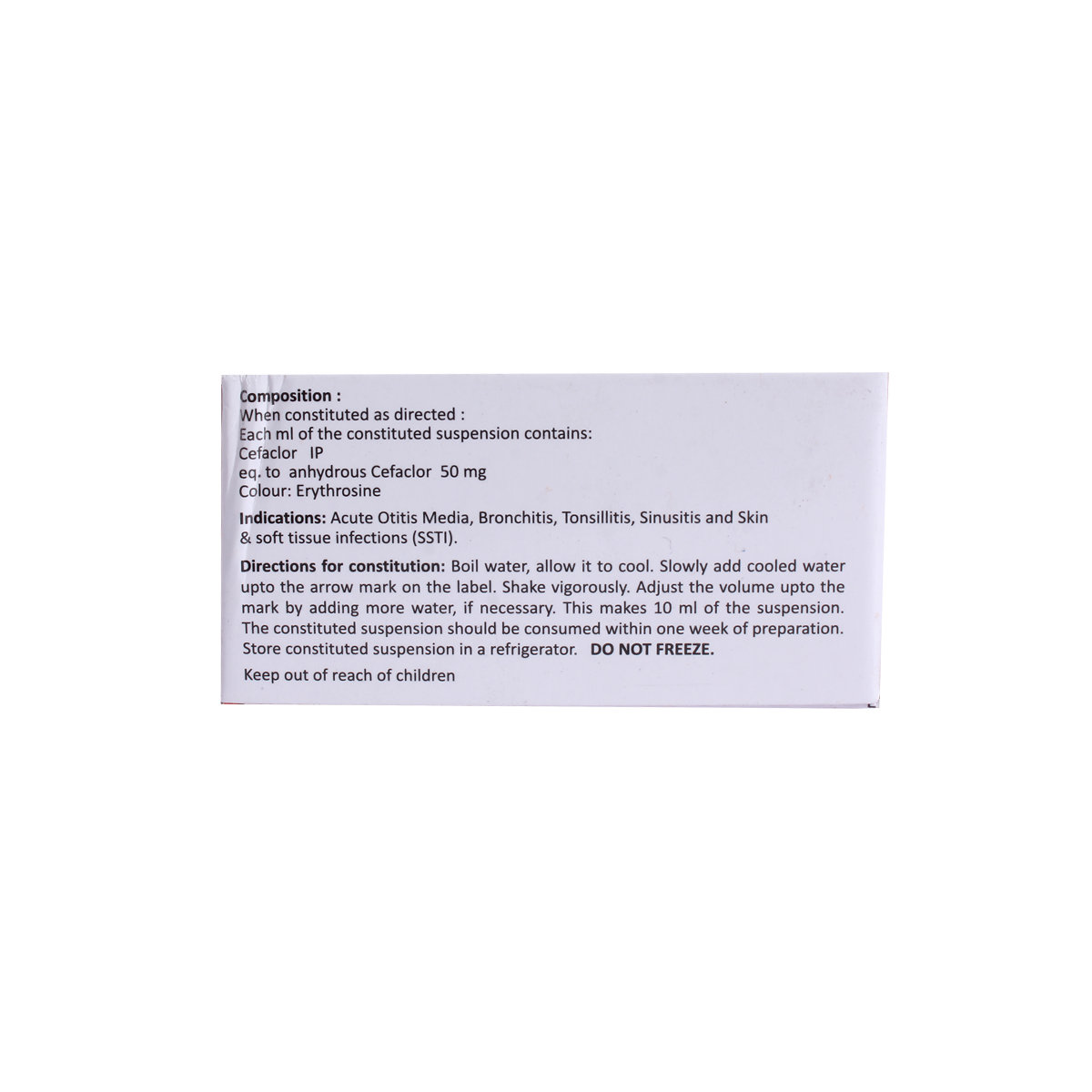Distaclor Drop




MRP ₹134
(Inclusive of all Taxes)
₹20.1 Cashback (15%)
know your delivery time
Provide Delivery Location
Composition :
Manufacturer/Marketer :
Consume Type :
Expires on or after :
Return Policy :

Secure Payment

Trusted by 8 Crore Indians

Genuine Products
Therapeutic Class
Country of origin
Manufacturer/Marketer address
Author Details
We provide you with authentic, trustworthy and relevant information
Disclaimer
Alcohol
Safe if prescribed
Avoid consumption of alcohol with Distaclor Drop as it may increase the risk of adverse effects.
Pregnancy
Consult your doctor
Distaclor Drop is a category B pregnancy drug and is given to pregnant women only if the doctor thinks benefits outweigh risks. Please consult a doctor if you are pregnant or planning for pregnancy.
Breast Feeding
Consult your doctor
Distaclor Drop may be excreted in human milk in small amounts. Therefore, it is given to breastfeeding mothers only if the doctor thinks benefits are greater than risks. Please consult a doctor if you are breastfeeding.
Driving
Safe if prescribed
Distaclor Drop usually does not affect your ability to drive or operate machinery.
Liver
Consult your doctor
Take Distaclor Drop with caution, especially if you have a history of Liver diseases/conditions. The dose may be adjusted by your doctor as required.
Kidney
Consult your doctor
Take Distaclor Drop with caution, especially if you have a history of Kidney diseases/conditions. The dose may be adjusted by your doctor as required.
Children
Safe if prescribed
The tablet form is not recommended for children. However, the syrup form should be used with caution in children above 1 month if prescribed by a doctor.
Keep Refrigerated. Do not freeze.Prepaid payment required.
About Distaclor Drop
Distaclor Drop belongs to a class of drugs called 'antibiotics' used to treat several bacterial infections of the urinary tract, respiratory tract, ears, nose, throat, skin and soft tissue. The bacterial infection is a condition in which harmful bacteria grows in the body and cause infection. It can infect any part of the body and multiple very quickly. Distaclor Drop does not work against infections, flu or cold symptoms caused by the virus.
Distaclor Drop contains Cefaclor an antibiotic that works by interfering with the formation of the bacterial cell wall (a protective covering) necessary for their survival. Thereby damages the bacterial cell wall and kills the bacterial cell. Thus, it prevents the growth of bacterial infection.
Take Distaclor Drop was prescribed by your doctor. You are advised to take Distaclor Drop for as long as your doctor has prescribed it for you based on your medical condition. You may experience vomiting, nausea, diarrhoea, vaginal itching, fever, and rash in some cases. Most of these side effects of Distaclor Drop do not require medical attention and gradually resolve over time. However, if the side effects persist or worsen, please consult your doctor.
If you are allergic to Distaclor Drop, penicillins or any other medicines, please tell your doctor. If you are pregnant or breastfeeding, please inform your doctor before taking Distaclor Drop. Distaclor Drop in tablet form is not recommended for children, but syrup form may be used in children above 1 month only in doses as prescribed by a doctor. If you are on dialysis, inform your doctor before taking Distaclor Drop to reduce the dose accordingly. Distaclor Drop may interact with certain tests such as glucose (sugar) in urine and give unusual results. Therefore, inform the doctor that you are using Distaclor Drop before undergoing any tests.
Uses of Distaclor Drop
Medicinal Benefits Mweb
Key Benefits
Distaclor Drop contains Cefaclor, a broad-spectrum antibiotic that acts against both aerobic (grow in the presence of oxygen) and anaerobic (grow in the absence of oxygen) gram-negative and gram-positive bacteria. It is used in the treatment of several bacterial infections of the urinary tract, respiratory tract, ears, nose, throat, skin, and soft tissue. Distaclor Drop interferes with the formation of the bacterial cell wall (a protective covering) necessary for their survival. Thereby damages the bacterial cell wall and kills bacteria.
Directions for Use
Tablet: Take it with or without food as advised by the doctor. Swallow it as a whole with a glass of water. Do not break, crush or chew it. Syrup: Take it by mouth using the measuring cup provided with the pack. Shake the bottle well before each use. Oral drops: Check the label for directions before use. Take it as advised by the doctor with the help of marked dropper.
Side Effects of Distaclor Drop
Nausea
- Vomiting
- Diarrhoea
- Vaginal itching
- Fever
- Rash
Drug Warnings
If you are allergic to Distaclor Drop, penicillins or any other medicines, please tell your doctor. If you have kidney problems, diabetes, stomach or intestinal disorder such as inflammation of the large intestine, inform your doctor before taking Distaclor Drop. If you are pregnant or breastfeeding, please inform your doctor before taking Distaclor Drop. Distaclor Drop in tablet form is not recommended for children, but syrup form may be used in children above 1 month only in doses as prescribed by a doctor. If you are on dialysis, inform your doctor before taking Distaclor Drop so that the dose may be reduced accordingly. Distaclor Drop may interact with certain tests such as glucose (sugar) in urine and give unusual results. Therefore, inform the doctor that you are using Distaclor Drop before undergoing any tests. You are recommended to complete the full course of Distaclor Drop as prescribed by your doctor for effective results.
Drug-Drug Interactions
Drug-Drug Interactions
Login/Sign Up
Drug-Food Interactions
Drug-Food Interactions
Login/Sign Up
Drug-Diseases Interactions
Drug-Diseases Interactions
Login/Sign Up
Drug-Drug Interactions Checker List
- WARFARIN
- PROBENECID
Habit Forming
Special Advise
If you are about to undergo blood or urine tests, inform your doctor that you are taking Distaclor Drop as it may interfere with these tests.
Diet & Lifestyle Advise
Take probiotics after completing the full course of Distaclor Drop to restore some healthy bacteria in the intestines that may have been killed. Taking probiotics after antibiotic treatment can reduce the risk of antibiotic-associated diarrhea. Certain fermented foods like cheese, yogurt, kombucha, sauerkraut, and kimchi can restore the good bacteria of the intestine.
Include fiber-rich foods, as they can be easily digested by your gut bacteria, which helps stimulate their growth. Thus, fiber-rich foods may help restore healthy gut bacteria after a course of antibiotics. Whole grains such as whole-grain bread and brown rice should be included in your diet.
Make sure you drink plenty of water or other fluids every day while you are taking Distaclor Drop.
Avoid alcohol consumption as it may increase adverse effects.

Have a query?
Buy best Infections & Infestation products by
Cipla Ltd
Macleods Pharmaceuticals Ltd
Alkem Laboratories Ltd
Lupin Ltd
Abbott India Ltd
Sun Pharmaceutical Industries Ltd
Mankind Pharma Pvt Ltd
Micro Labs Ltd
Aristo Pharmaceuticals Pvt Ltd
FDC Ltd
Intas Pharmaceuticals Ltd
Glenmark Pharmaceuticals Ltd
Ipca Laboratories Ltd
Torrent Pharmaceuticals Ltd
Zydus Healthcare Ltd
Biochem Pharmaceutical Industries Ltd
Zuventus Healthcare Ltd
United Biotech Pvt Ltd
Hetero Drugs Ltd
Emcure Pharmaceuticals Ltd
Alembic Pharmaceuticals Ltd
Indoco Remedies Ltd
Fusion Health Care Pvt Ltd
Dr Reddy's Laboratories Ltd
Leeford Healthcare Ltd
Cadila Healthcare Ltd
Wockhardt Ltd
Zydus Cadila
GlaxoSmithKline Pharmaceuticals Ltd
Morepen Laboratories Ltd
Blue Cross Laboratories Pvt Ltd
Cadila Pharmaceuticals Ltd
Converge Biotech Pvt Ltd
Elder Pharmaceuticals Ltd
Hetero Healthcare Pvt Ltd
Pfizer Ltd
AAA Pharma Trade Pvt Ltd
Gufic Bioscience Ltd
Mylan Pharmaceuticals Pvt Ltd
Corona Remedies Pvt Ltd
Wallace Pharmaceuticals Pvt Ltd
Apex Laboratories Pvt Ltd
Medishri Healthcare Pvt Ltd
Akumentis Healthcare Ltd
Alniche Life Sciences Pvt Ltd
Hegde & Hegde Pharmaceutica Llp
Veritaz Healthcare Ltd
Ranbaxy Laboratories Ltd
Koye Pharmaceuticals Pvt Ltd
Shreya Life Sciences Pvt Ltd
Overseas Health Care Pvt Ltd
Biocon Ltd
Indchemie Health Specialities Pvt Ltd
Medley Pharmaceuticals Ltd
Brinton Pharmaceuticals Ltd
J B Chemicals & Pharmaceuticals Ltd
Unifaith Biotech Pvt Ltd
Ajanta Pharma Ltd
Biochemix Health Care Pvt Ltd
Natco Pharma Ltd
Samarth Life Sciences Pvt Ltd
Unichem International
Laborate Pharmaceuticals India Ltd
Unipark Biotech Pvt Ltd
Zymes Bioscience Pvt Ltd
Indiabulls Pharmaceuticals Pvt Ltd
Neon Laboratories Ltd
Vasu Organics Pvt Ltd
DR Johns Lab Pharma Pvt Ltd
East West Pharma India Pvt Ltd
La Renon Healthcare Pvt Ltd
Medgen Drugs And Laboratories Pvt Ltd
Novartis India Ltd
Canixa Life Sciences Pvt Ltd
Icarus Health Care Pvt Ltd
Lincoln Pharmaceuticals Ltd
Celon Laboratories Pvt Ltd
Concept Pharmaceuticals Ltd
Klm Laboratories Pvt Ltd
Nicholas Piramal India Ltd
Systopic Laboratories Pvt Ltd
Yuventis Pharmaceuticals
Capital Pharma
German Remedies Ltd
Pristine Pearl Pharma Pvt Ltd
Unison Pharmaceuticals Pvt Ltd
Aurz Pharmaceutical Pvt Ltd
Clover Health Care Pharma
Kepler Healthcare Pvt Ltd
Allites Life Sciences Pvt Ltd
Auspharma Pvt Ltd
Intra Life Pvt Ltd
Jolly Healthcare
Linux Laboratories Pvt Ltd
Ozone Pharmaceuticals Ltd
Cachet Pharmaceuticals Pvt Ltd
Comed Chemicals Ltd
Delcure Life Sciences Ltd
Fresenius Kabi India Pvt Ltd
Khandelwal Laboratories Pvt Ltd



